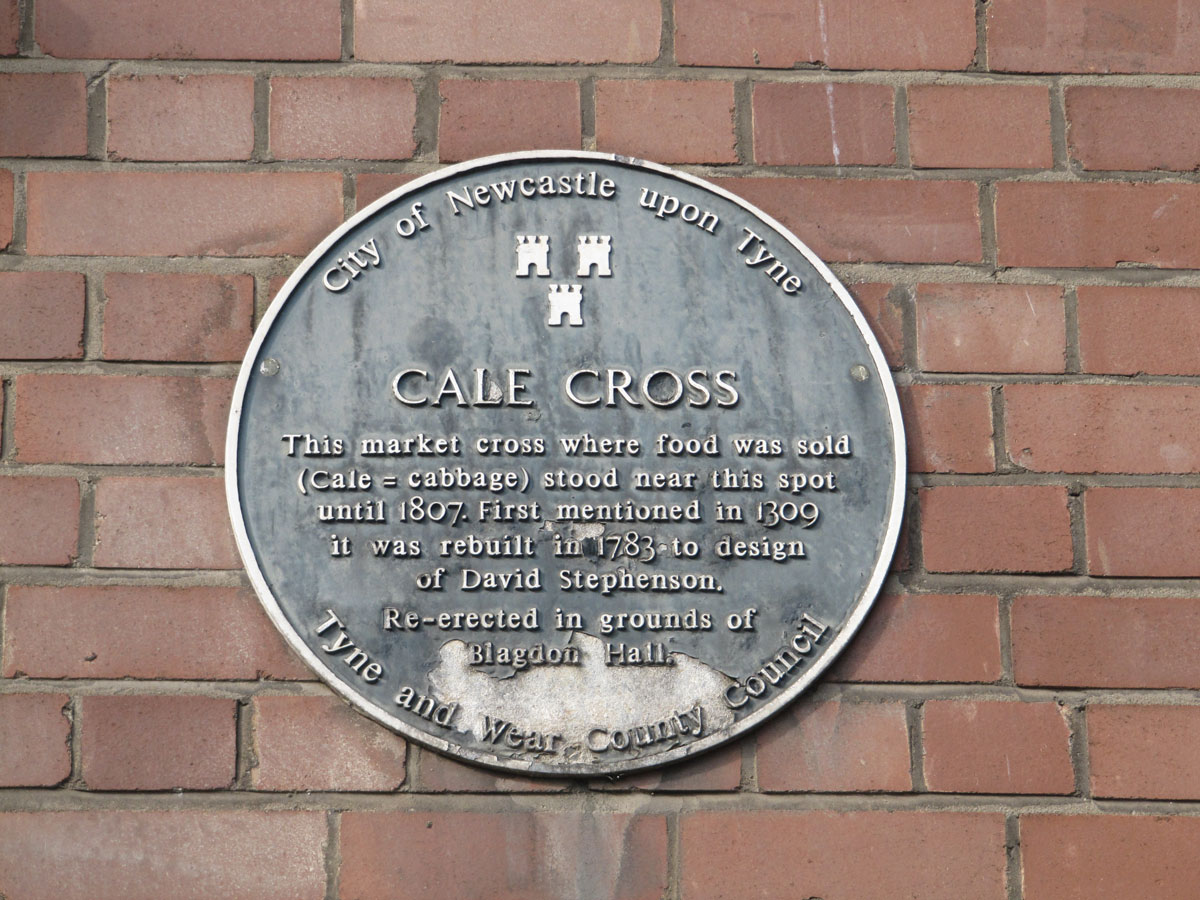Contributory members are able to log private notes and comments about each site
Sites Anne T has logged on trip number: 148 (View all trips)
View this log as a table or view the most recent logs from everyone
Cale Cross (Newcastle)
Trip No.148 Entry No.2 Date Added: 9th Sep 2019
Site Type: Ancient Cross
Country: England (Tyne and Wear)
Visited: Yes on 7th Sep 2019. My rating: Condition -1 Ambience 3 Access 5

Cale Cross (Newcastle) submitted by Anne T on 9th Sep 2019. The blue plaque is currently the only sign that the Cale (or Cabbage) cross stood at or near this location.
(View photo, vote or add a comment)
Log Text: Site of Cale Cross (Newcastle): The plaque commemorating this cross is attached the eastern wall of what I think is 3, Akenside Hill (or possibly Akenside House), on the Quayside, just to the west of the A167 where it is about to go south over the Tyne Bridge, and just north-north-east of the Swing Bridge.
The building sits at the junction of Dean Street and Queen Street, just before Dean Street meets Sandhill (the B1600) and Quayside. I imagine in olden times, this would have been the ideal place for a market.
It was the afternoon before the main Great North Run and Quayside was hugely busy with other races starting and finishing. What a crowd, but a lively, friendly atmosphere. I had great fun finding my way back up the hill through tiny lanes I didn’t know existed, passing the Church of All Saints, a huge viaduct, some of the old city walls and Castle Keep.
The plaque reads: “City of Newcastle upon Tyne. Cale Cross. This market cross where food was sold (cale = cabbage) stood near this spot until 1807. First mentioned in 1309 it was rebuilt in 1783 to design of David Stephenson. Re-erected in the grounds of Blagdon Hall Tyne and Wear County Council”.
If the original cross had gone to Blagdon Hall, I would have set off in search of it, but this is only the 1783 re-design.
White Cross (Newcastle)
Trip No.148 Entry No.1 Date Added: 9th Sep 2019
Site Type: Ancient Cross
Country: England (Tyne and Wear)
Visited: Yes on 7th Sep 2019. My rating: Condition -1 Ambience 3 Access 4

White Cross (Newcastle) submitted by Anne T on 9th Sep 2019. The metal plaque set into the pavement showing the location of the White Cross, first recorded in local history in 1410. The image shows how was rebuilt in 1783, having been a simple market cross, then a pillar and dial, then a cistern for water, then a stone pillar. We know in 1701 a white thorn tree grew nearby, as a man named John Fenwick was hanged from this tree after murdering a local MP called Fernando Forster.
(View photo, vote or add a comment)
Log Text: Site of the White Cross (Newcastle): Having typed 'Cross' and 'Newcastle' into Pastscape, I was surprised to find two crosses come up. So, armed with my GPS I set off to try and find these sites.
This cross used to be located at the corner of Newgate Street and Low Friar Street, north west of the junction of Clayton Street and Newgate Street.
I cross the road regularly here to walk through the lane to the side of the Gate, down towards West Walls and Akhbar’s, but this is a part of the pavement I’ve never been on. About 30m to the south east (following the pavement), outside what is now Debenham’s, a large metal plaque is set into the pavement.
The plaque reads: The White Cross. A medieval market cross, first mentioned around 1410, once stood here. / Sited on Newgate Street near to the junction with Low Friar Street (opposite), for almost 400 years, it marked the main entrance into a host of markets including the Bigg Market, Poultry Market, Groat Market, Wool Market, Iron Market and the Flesh Market. Many of the market names are still in use today as street names within the city centre. / The ‘White Cross’ has taken on at least five different appearances. Originally a simple market cross, it also appeared as a pillar & dial, a cistern for the ‘New Water’ and a stone pillar. / In 1783 it was demolished and rebuilt to the design shown here by David Stephenson, a local Architect who also designed the original Theatre Royal in Mosley Street. It had a pretty little spire, with a good clock, and was ornamented on the four sides with the arms of the Mayor, Magistrates and Sheriff. / In 1808 it was dismantled and rebuilt at the north end of the Flesh Market on the current site of Grey Street. / On 22nd August 1701 a famous incident between Ferdinando Forster MP for Northumberland and John Fenwick of Rock, coal owner, took place at the White Cross. / Whilst attending a ‘Grand Jury’ at the Black Horse Inn, near the crossroads of Clayton Street and Newgate Street the two men argued about family matters. Fenwick challenged Forster and as they went out stabbed Forster from behind. Fenwick escaped but was caught within a week, tried and executed by hanging from the white thorn tree that grew close to the White Cross on 25th September 1701.”
